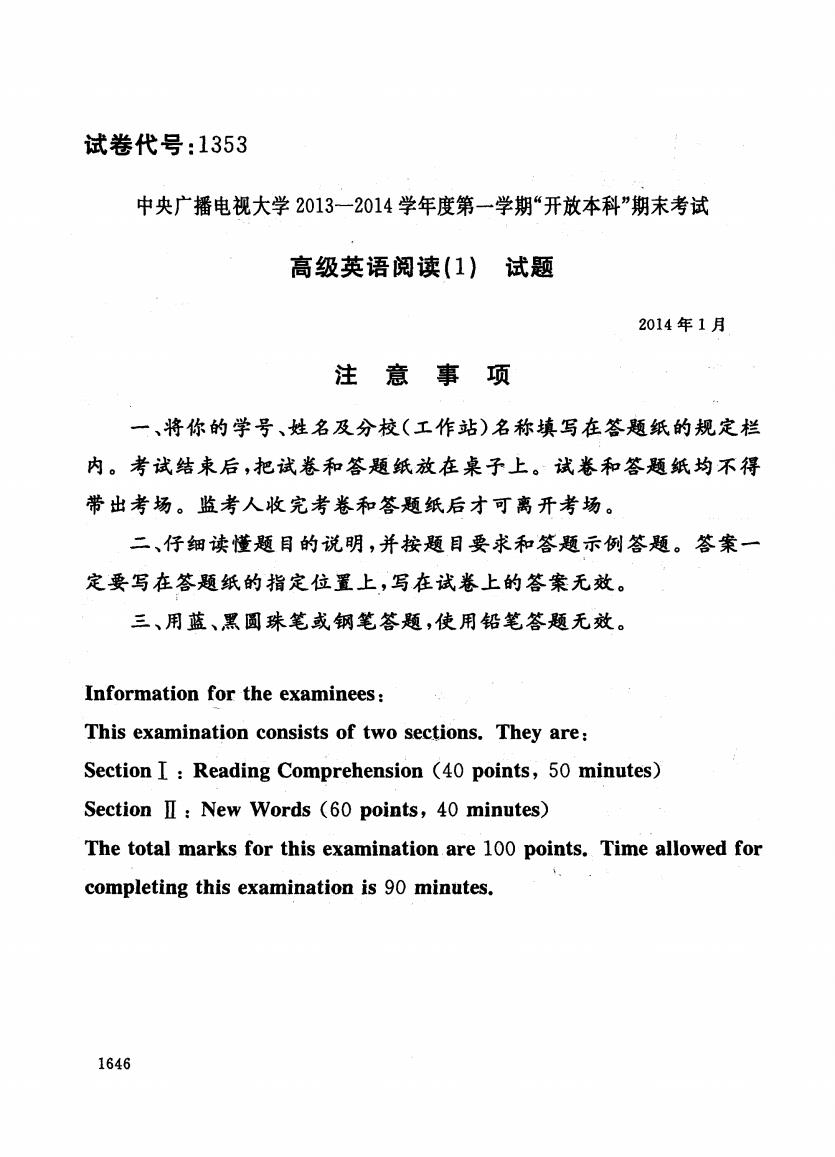
试卷代号:1353 中央广播电视大学2013一2014学年度第一学期“开放本科”期末考试 高级英语阅读(1)试题 2014年1月 注意事项 一、将你的学号、姓名及分校(工作站)名称填写在答题纸的规定栏 内。考试结束后,把试卷和答题纸放在桌予上。试卷和答题纸均不得 带出考场。监考人收完考卷和答题纸后才可离开考场。 二、仔细读懂题目的说明,并按题目要求和答题示例答题。答案一 定要写在答题纸的指定位置上,写在试卷上的答案无效。 三、用蓝、黑圆珠笔或钢笔答题,使用铅笔答题无效。 Information for the examinees: This examination consists of two sections.They are: Section I:Reading Comprehension (40 points,50 minutes) SectionⅡ:New Words(60 points,40 minutes) The total marks for this examination are 100 points.Time allowed for completing this examination is 90 minutes. 1646
试卷代号 中央广播电视大学 4学年度第一学期"开放本科"期末考试 高级英语阅读 )试题 2014 年1 注意事项 一、将你的学号、姓名及分校(工作站〉名称填写在答题纸的规定栏 内。考试结束后,把试卷和答题妖放在桌子上。试卷和答题纸均不得 带出考场。监考人收完考卷和答题纸后才可离开考场。 二、仔细读懂题目的说明,并按题目要求和答题示例答题。答案一 定要写在答题纸的指定位置上,写在试卷土的答案元效。 三、用蓝、黑圆珠笔或钢笔答题,使用铅笔答题无效。 Information forthe examinees: This examination consists of two s.ec.tions. They are: Section I : Reading Comprehension (40 points, 50 minutes) Section II : New Words (60 points, 40 minutes) The total marks for this examination are 100 points. Time allowed for completing this examination is 90 minutes. 1646
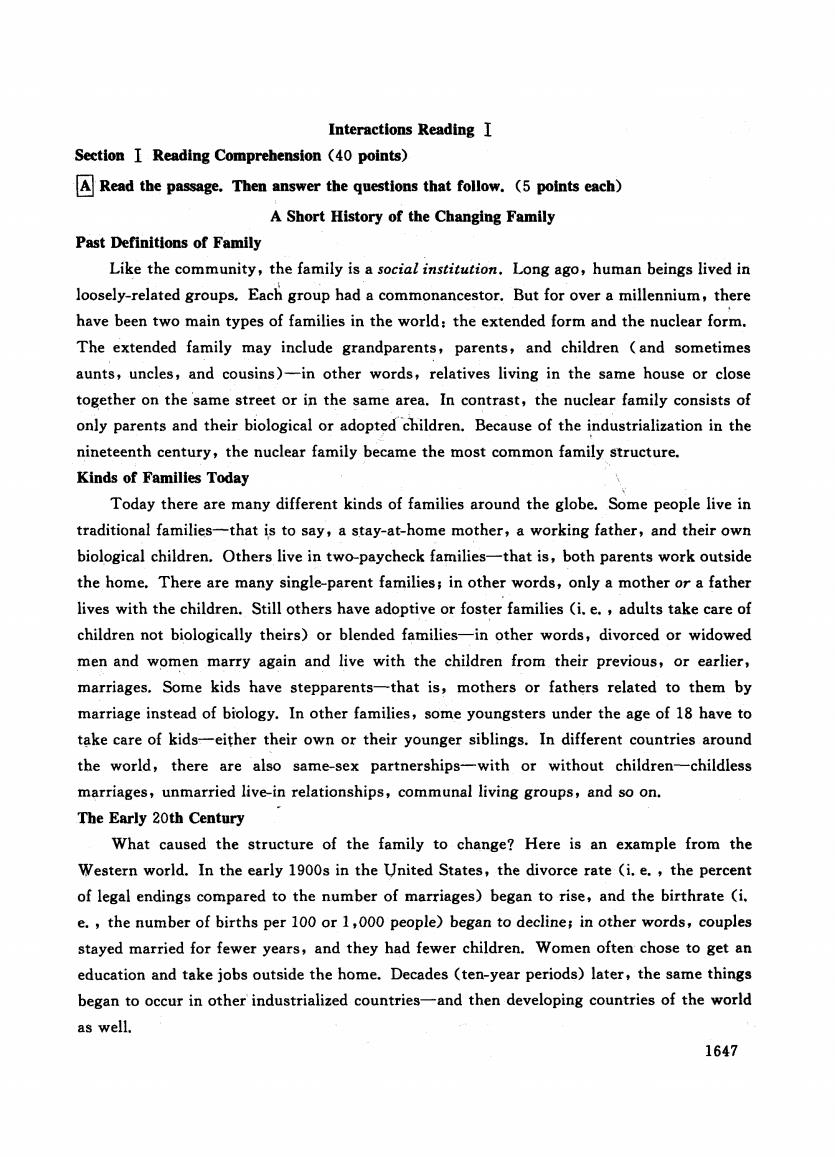
Interactions Reading I Section I Reading Comprehension(40 points) A Read the passage.Then answer the questions that follow.(5 points each) A Short History of the Changing Family Past Definitions of Family Like the community,the family is a social institution.Long ago,human beings lived in loosely-related groups.Each group had a commonancestor.But for over a millennium,there have been two main types of families in the world:the extended form and the nuclear form. The extended family may include grandparents,parents,and children (and sometimes aunts,uncles,and cousins)-in other words,relatives living in the same house or close together on the same street or in the same area.In contrast,the nuclear family consists of only parents and their biological or adopted children.Because of the industrialization in the nineteenth century,the nuclear family became the most common family structure. Kinds of Families Today Today there are many different kinds of families around the globe.Some people live in traditional families-that is to say,a stay-at-home mother,a working father,and their own biological children.Others live in two-paycheck families-that is,both parents work outside the home.There are many single-parent families;in other words,only a mother or a father lives with the children.Still others have adoptive or foster families (i.e.,adults take care of children not biologically theirs)or blended families-in other words,divorced or widowed men and women marry again and live with the children from their previous,or earlier, marriages.Some kids have stepparents-that is,mothers or fathers related to them by marriage instead of biology.In other families,some youngsters under the age of 18 have to take care of kids-either their own or their younger siblings.In different countries around the world,there are also same-sex partnerships-with or without children-childless marriages,unmarried live-in relationships,communal living groups,and so on. The Early 20th Century What caused the structure of the family to change?Here is an example from the Western world.In the early 1900s in the United States,the divorce rate (i.e.,the percent of legal endings compared to the number of marriages)began to rise,and the birthrate (i. e.,the number of births per 100 or 1,000 people)began to decline;in other words,couples stayed married for fewer years,and they had fewer children.Women often chose to get an education and take jobs outside the home.Decades (ten-year periods)later,the same things began to occur in other industrialized countries-and then developing countries of the world as well, 1647
Interactions Reading I 配tion I Reading Comprehension (40 points) ass Th… er qu that follow. (5 poi A Short History of the Changing Family Past Definitions of Family Like the community, the family is a social institution. Long ago , human beings lived in looseiy-relaMgroups.Each group had a commonancestor-But for over a IIlinenniurn ,there have been two main types of families in the world: the extended form and the nuclear form. The extended family may include grandparents, parents, and children (and sometimes aunts, uncles, and cousins)一in other words, relatives living in the same house or close together on thesame street or in the same area. In contrast, the nuclear family consists of only parents and their biological or adoptecCchildren. Because of the industrialization in the nineteenth century, the nuclear family became the most common family Structure. Kinds of Famili臼Today Today there are many different kinds of families around the globe. Some people live in traditional families-that i,s to say , a stay-at-home mother, a working father, and their own biological children. Others live in two-paycheck families-that is, both parents work outside the home. There are many single-parent families; in other words, onlya mother or a father lives with the children. Still others have adoptive or foster families 0. e. , adults take care of children not biologically theirs) or blended families-in other words, divorced or widowed men and women marry again and live with the children from their previous, or earlier, marriages. Some kids have stepparents-that is, mothers or fathers related to them by marriage instead of biology. In other families, some youngsters under the age of 18 have to t~ke care of kids-ei~her their own or their younger siblings. In different countries around the world , there are also same-sex partnerships-with or without children-childless marriages, unmarried live-in relationships, communalliving groups, and so on. The Early 20th Century What caused the structure of the family to change? Here is an example from the Western world. In the early 1900s in the United States, the divorce rate 0. e. , the percent of legal endings compared to the number of marriages) began torise , and the birthrate 0. e. , the number of births per 100 or 1 ,000 people) began to decline; in other words, couples stayed married for fewer years, and they had fewer children. Women often chose to get an education and take jobs outside the home. Decades (ten-year periods) later, the same things began to occur in other industrialized countries-and then developing countries of the world as well. 1647
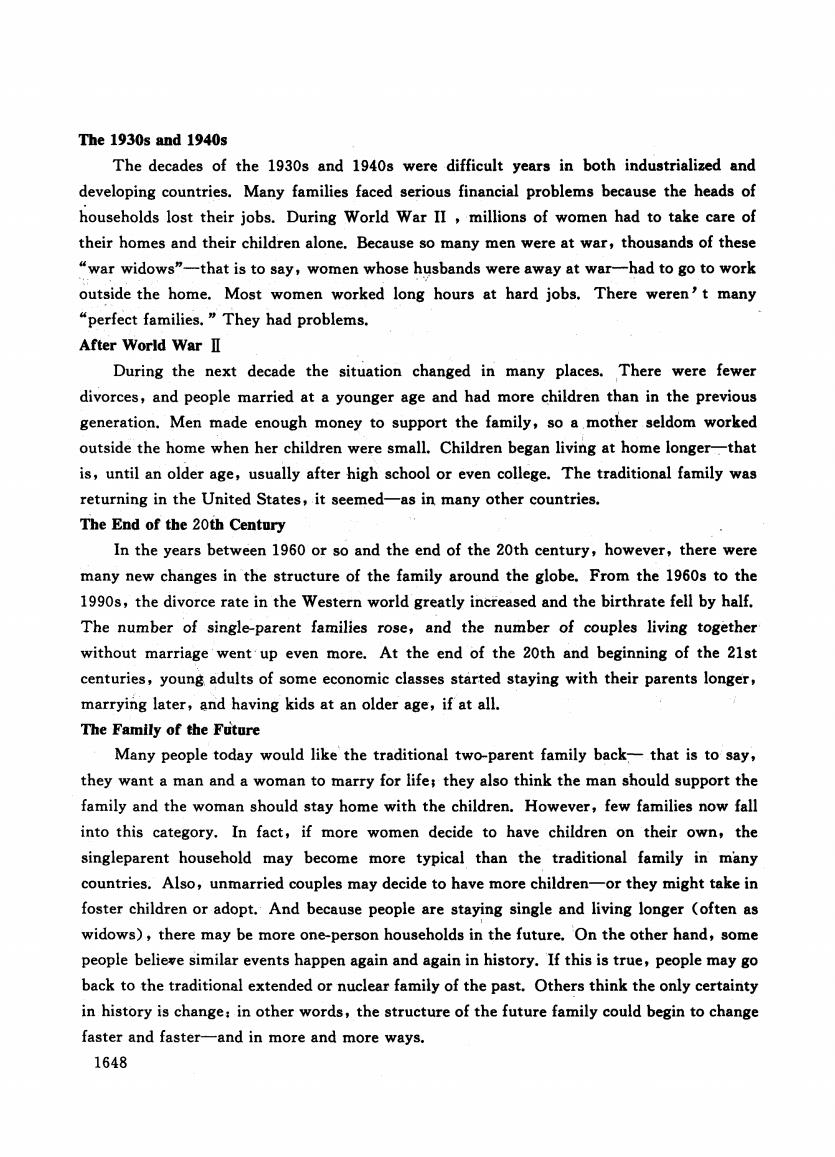
The 1930s and 1940s The decades of the 1930s and 1940s were difficult years in both industrialized and developing countries.Many families faced serious financial problems because the heads of households lost their jobs.During World War II,millions of women had to take care of their homes and their children alone.Because so many men were at war,thousands of these "war widows"-that is to say,women whose husbands were away at war-had to go to work outside the home.Most women worked long hours at hard jobs.There weren't many “perfect families..”They had problems.. After World War II During the next decade the situation changed in many places.There were fewer divorces,and people married at a younger age and had more children than in the previous generation.Men made enough money to support the family,so a mother seldom worked outside the home when her children were small.Children began living at home longer-that is,until an older age,usually after high school or even college.The traditional family was returning in the United States,it seemed-as in many other countries. The End of the 20th Century In the years between 1960 or so and the end of the 20th century,however,there were many new changes in the structure of the family around the globe.From the 1960s to the 1990s,the divorce rate in the Western world greatly increased and the birthrate fell by half. The number of single-parent families rose,and the number of couples living together without marriage went up even more.At the end of the 20th and beginning of the 21st centuries,young adults of some economic classes started staying with their parents longer, marrying later,and having kids at an older age,if at all. The Family of the Future Many people today would like the traditional two-parent family back-that is to say, they want a man and a woman to marry for life;they also think the man should support the family and the woman should stay home with the children.However,few families now fall into this category.In fact,if more women decide to have children on their own,the singleparent household may become more typical than the traditional family in many countries.Also,unmarried couples may decide to have more children-or they might take in foster children or adopt.And because people are staying single and living longer (often as widows),there may be more one-person households in the future.On the other hand,some people believe similar events happen again and again in history.If this is true,people may go back to the traditional extended or nuclear family of the past.Others think the only certainty in history is change:in other words,the structure of the future family could begin to change faster and faster-and in more and more ways. 1648
The 19305 and 19405 The decades of the 1930s and 1940s were difficult years in both industrialized and developing countries. Many families faced serious financial problems because the heads of households lost their jobs. During World War II , millions of women had to take care of their homes and their children alone. Because so many men were at war, thousands of these "war widows"一that is to say , women whose husbands were away at war-…-had to go to work 。u the home. Most women worked long hours at hard jobs. There weren' t many "perfect families. " They had problems. After World War II During the next decade the situation changed in many places. There were fewer divorces, and people married at a younger age and had more children than in the previous generation. Men made enough money to support the family , so a .mother seldom worked outside the home when her children were small. Children began living at home longer-:-that is, until an older age , usually after high school or even college. The traditional family was returning in the United States,it seemed-as in many other countries. The End of the 20th Century In the years between 1960 or so and the end of the 20th century, however, there were many new changes in the structure of the family around the globe. From the 1960s to the 1990s, the divorce rate in the Western worldgreatly increased and the birthrate fell by half. The number of single-parent families rose, and the number of couples living together without marriage went up even more. At the end of the 20th and beginning of the 21st centuries, young adults of some economic classes started staying with their parents longer, marryitl.g later, arid having kids at an older age , if at all. FanJily of 曲eFuture Many people today would like the traditional two-parent family back-:- that is to say , they want a man and a woman to marry for life; they also think the man should support the family and the woman should stay home with the children. However, few families now fall into this category. In fact , if more women decide to have children on their own, the singleparent household may become more typical than the traditional family in many countries. Also , unmarried couples may decide to have more children一or they might take in foster children or adopt. And because people are staying single and living longer (often as widows) , there may be more one-person households in the future.On the other hand , some people beli~e similar events happen
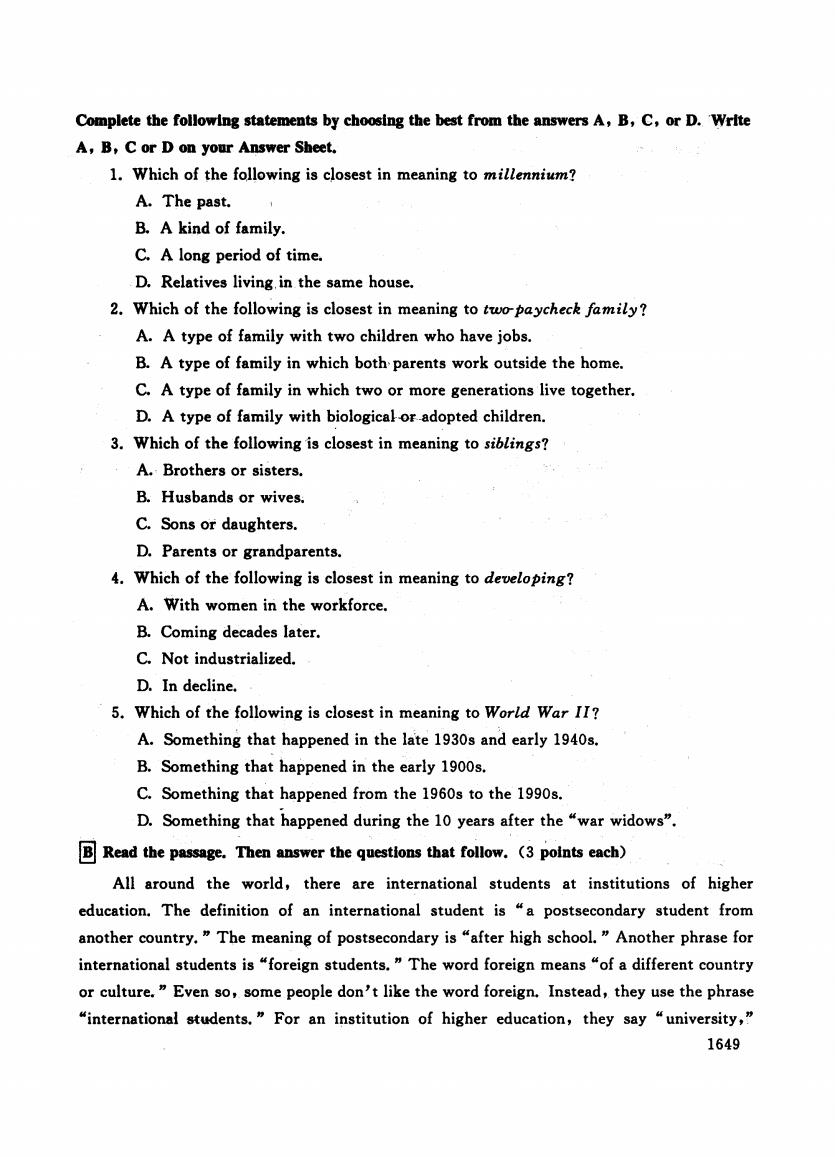
Complete the following statements by choosing the best from the answers A,B,C,or D.Wrlte A,B,C or D on your Answer Sheet. 1.Which of the following is closest in meaning to millennium? A.The past. B.A kind of family. C.A long period of time. D.Relatives living.in the same house. 2.Which of the following is closest in meaning to two paycheck family? A.A type of family with two children who have jobs. B.A type of family in which both parents work outside the home. C.A type of family in which two or more generations live together. D.A type of family with biological or adopted children. 3.Which of the following is closest in meaning to siblings? A.Brothers or sisters. B.Husbands or wives. C.Sons or daughters. D.Parents or grandparents. 4.Which of the following is closest in meaning to developing? A.With women in the workforce. B.Coming decades later. C.Not industrialized. D.In decline. 5.Which of the following is closest in meaning to World War II? A.Something that happened in the late 1930s and early 1940s. B.Something that happened in the early 1900s. C.Something that happened from the 1960s to the 1990s. D.Something that happened during the 10 years after the "war widows". BRead the passage.Then answer the questions that follow.(3 points each) All around the world,there are international students at institutions of higher education.The definition of an international student is "a postsecondary student from another country."The meaning of postsecondary is"after high school.Another phrase for international students is "foreign students.The word foreign means "of a different country or culture.Even so,some people don't like the word foreign.Instead,they use the phrase “international students,.”For an institution of higher education,they say“university,” 1649
Complete the following statements by cb og best from the answers A, B, C, or D. 'Write A, B, Cor D on your Answer Sh 1. Which of ~he following is closest in meaning to millennium? A. The past. B. A kind of family. C. A long period of time. D. Relatives living , in the same house. 2. Which of the following is closest in meaning to tw ec family? A. A type of family with two children who have jobs. B. A type of family in which both,parents work outside the home. C. A type of family in which two or more generationslive together. D. A type of family with biologicalc-ot'-adopted children. 3. Which of the followingis closest in meaning to siblings? A. Brothers or sisters. B. H usbandsor wives; C. Sons or daughters. D. Parents or grandparents. 4. Which of the following is closest in meaning to developing? A. With women in the workforce. B. Coming decades later. C. Not industrialized. D. In decline. 5. Which of the following is closest in meaning to World War II? A. Something that happened in the laie 1930s and early 1940s. B. Something that happened in the early 1900s. C. Something that happened from the 1960s to the 1990s. D. Something that happened during the 10 years after the "war widows". ea assage Then 川he qu臼tions 伽t follow. (3 pol All around the world , there are international students at institutions of higher education. The definition of an international student is "a postsecondary student from another country. " The meaning of postsecondary is "after high school. " Another phrase for international students is "foreign students. " The word foreign means "of a different country or culture." Even so , some people don' t like the word foreign. Instead , they use the phrase "internationals在udents." For an institution of higher education, they say" university ,r 1649
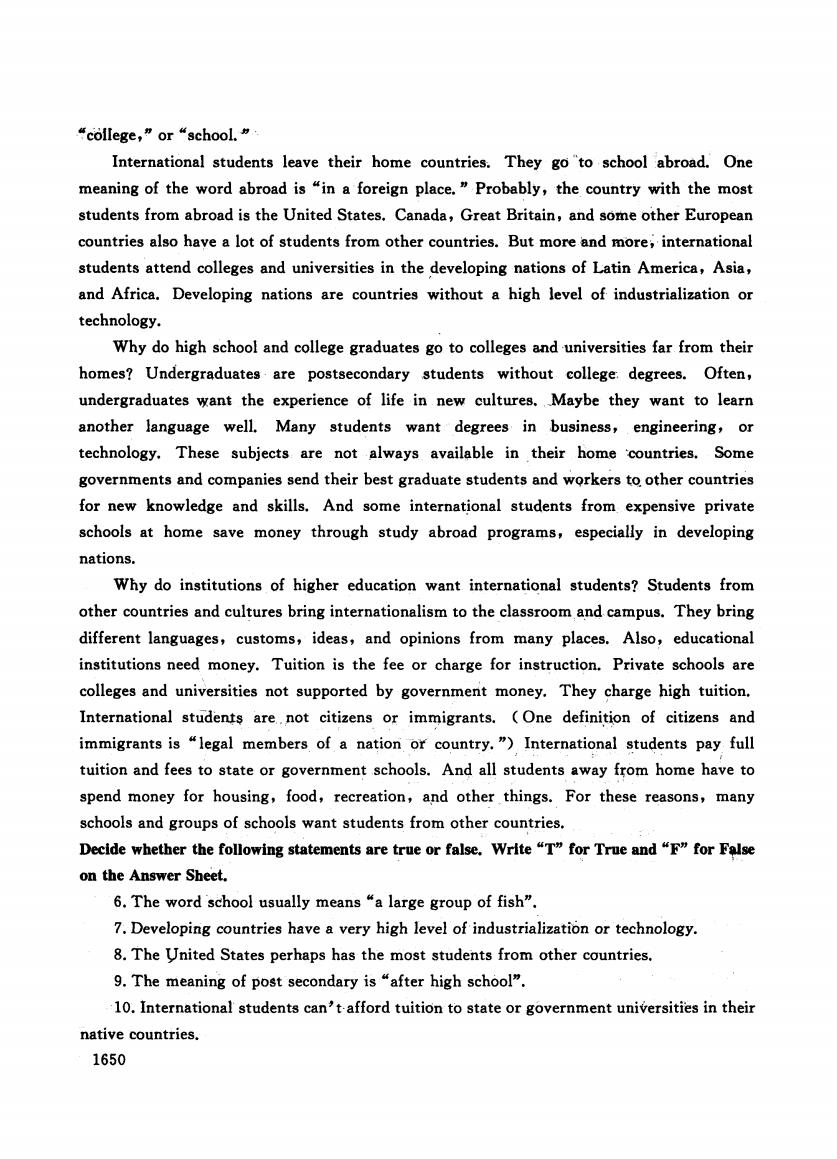
“college,”or“school.”: International students leave their home countries.They go to school abroad.One meaning of the word abroad is "in a foreign place."Probably,the country with the most students from abroad is the United States.Canada,Great Britain,and some other European countries also have a lot of students from other countries.But more and more,international students attend colleges and universities in the developing nations of Latin America,Asia, and Africa.Developing nations are countries without a high level of industrialization or technology. Why do high school and college graduates go to colleges and universities far from their homes?Undergraduates are postsecondary students without college.degrees.Often, undergraduates want the experience of life in new cultures.Maybe they want to learn another language well.Many students want degrees in business,engineering,or technology.These subjects are not always available in their home 'countries.Some governments and companies send their best graduate students and workers to other countries for new knowledge and skills.And some international students from expensive private schools at home save money through study abroad programs,especially in developing nations. Why do institutions of higher education want international students?Students from other countries and cultures bring internationalism to the classroom and campus.They bring different languages,customs,ideas,and opinions from many places.Also,educational institutions need money.Tuition is the fee or charge for instruction.Private schools are colleges and universities not supported by government money.They charge high tuition. International students are.not citizens or immigrants.(One definition of citizens and immigrants is "legal members of a nation or country.")International students pay full tuition and fees to state or government schools.And all students away from home have to spend money for housing,food,recreation,and other things.For these reasons,many schools and groups of schools want students from other countries. Decide whether the following statements are true or false..Write“T”for True and“r”for False on the Answer Sheet. 6.The word school usually means "a large group of fish". 7.Developing countries have a very high level of industrialization or technology. 8.The United States perhaps has the most students from other countries. 9.The meaning of post secondary is "after high school". 10.International students can't afford tuition to state or government universities in their native countries. 1650
·college, n or "school.» International students leave their home countries. They go "to schoolabroad. One meaning of the word abroad is "in a foreign place. " Probably, the country with the most students from abroad is the United States. Canada , Great Britain , and some other European countries also have a lot of students from other countries. But moreand mbre; international students attend colleges and universities in the developing nations of Lat in America , Asia , and Africa. Developing nations are countries without a high level of industrialization or technology. Why do high school and college graduates go to colleges anduniversities far from their homes? Undergraduates are postsecondary ,students withoutcollege, degrees. Often, undergraduates want the experience of life in new cultures. 、Maybe they want to learn another language well. Many students want degrees in ,business, engineering , or technology. These subjects are not ,always availllble in their home ':COuntries. Some governments and companies send their best graduate students and wQrkers 1;0. other countries for new knowledge and skills. And some internatjonal students from expensive private schools at home save money through study abroad programs, especially in developing nations. Why do institutions of higher education want international students? Students from other countries and cultures bring internationalism to the classroomand campus. They bring different languages, customs, ideas, and opinions from many places. Also , educational institutions need money. Tuition is the fee or charge for instruction. Private schools are colleges and universities not supported by government money. They charge lJ,igh tuition. International student串are" not citizens Or im1l).igrants. (One defini~ion of citizens and immigrants is "legal members of a nation or country. 勺International students pay full tuition and fees to state or governmentschools. And all students away fJ;"om home have to spend money for housing , food , recreation , a~d other things. For these reasons, many schools and groups of schools want students from other countries. 配ide whether the following statements are true or false. Write "T" for True and "F" for F~se on the Answer Sheet. 6. The word school usually means "a large group of fish". 7. Developing countries have a very high level ofindustrializati6n or technology. 8. The l)nited States perhaps has the most students from other countries. 9. The meaning of post secondary is "after high school". 10. International students can't·afford tuitionto state or government uni"ersiti臼in their native countnes. 1650